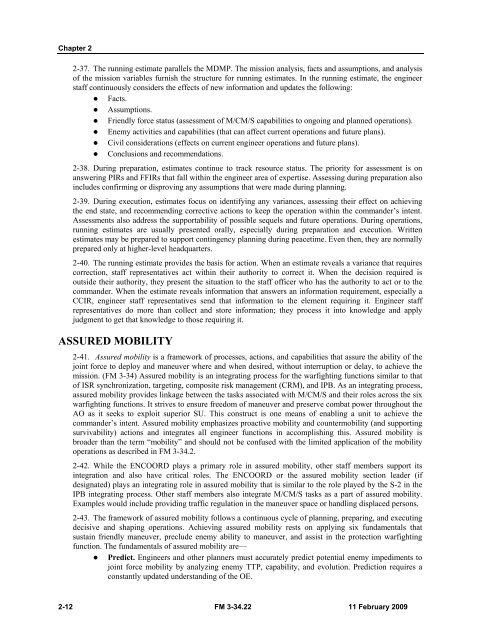FM 3-34.22 - Army Electronic Publications & Forms - U.S. Army
FM 3-34.22 - Army Electronic Publications & Forms - U.S. Army
FM 3-34.22 - Army Electronic Publications & Forms - U.S. Army
Create successful ePaper yourself
Turn your PDF publications into a flip-book with our unique Google optimized e-Paper software.
Chapter 2<br />
2-37. The running estimate parallels the MDMP. The mission analysis, facts and assumptions, and analysis<br />
of the mission variables furnish the structure for running estimates. In the running estimate, the engineer<br />
staff continuously considers the effects of new information and updates the following:<br />
� Facts.<br />
� Assumptions.<br />
� Friendly force status (assessment of M/CM/S capabilities to ongoing and planned operations).<br />
� Enemy activities and capabilities (that can affect current operations and future plans).<br />
� Civil considerations (effects on current engineer operations and future plans).<br />
� Conclusions and recommendations.<br />
2-38. During preparation, estimates continue to track resource status. The priority for assessment is on<br />
answering PIRs and FFIRs that fall within the engineer area of expertise. Assessing during preparation also<br />
includes confirming or disproving any assumptions that were made during planning.<br />
2-39. During execution, estimates focus on identifying any variances, assessing their effect on achieving<br />
the end state, and recommending corrective actions to keep the operation within the commander’s intent.<br />
Assessments also address the supportability of possible sequels and future operations. During operations,<br />
running estimates are usually presented orally, especially during preparation and execution. Written<br />
estimates may be prepared to support contingency planning during peacetime. Even then, they are normally<br />
prepared only at higher-level headquarters.<br />
2-40. The running estimate provides the basis for action. When an estimate reveals a variance that requires<br />
correction, staff representatives act within their authority to correct it. When the decision required is<br />
outside their authority, they present the situation to the staff officer who has the authority to act or to the<br />
commander. When the estimate reveals information that answers an information requirement, especially a<br />
CCIR, engineer staff representatives send that information to the element requiring it. Engineer staff<br />
representatives do more than collect and store information; they process it into knowledge and apply<br />
judgment to get that knowledge to those requiring it.<br />
ASSURED MOBILITY<br />
2-41. Assured mobility is a framework of processes, actions, and capabilities that assure the ability of the<br />
joint force to deploy and maneuver where and when desired, without interruption or delay, to achieve the<br />
mission. (<strong>FM</strong> 3-34) Assured mobility is an integrating process for the warfighting functions similar to that<br />
of ISR synchronization, targeting, composite risk management (CRM), and IPB. As an integrating process,<br />
assured mobility provides linkage between the tasks associated with M/CM/S and their roles across the six<br />
warfighting functions. It strives to ensure freedom of maneuver and preserve combat power throughout the<br />
AO as it seeks to exploit superior SU. This construct is one means of enabling a unit to achieve the<br />
commander’s intent. Assured mobility emphasizes proactive mobility and countermobility (and supporting<br />
survivability) actions and integrates all engineer functions in accomplishing this. Assured mobility is<br />
broader than the term “mobility” and should not be confused with the limited application of the mobility<br />
operations as described in <strong>FM</strong> 3-34.2.<br />
2-42. While the ENCOORD plays a primary role in assured mobility, other staff members support its<br />
integration and also have critical roles. The ENCOORD or the assured mobility section leader (if<br />
designated) plays an integrating role in assured mobility that is similar to the role played by the S-2 in the<br />
IPB integrating process. Other staff members also integrate M/CM/S tasks as a part of assured mobility.<br />
Examples would include providing traffic regulation in the maneuver space or handling displaced persons.<br />
2-43. The framework of assured mobility follows a continuous cycle of planning, preparing, and executing<br />
decisive and shaping operations. Achieving assured mobility rests on applying six fundamentals that<br />
sustain friendly maneuver, preclude enemy ability to maneuver, and assist in the protection warfighting<br />
function. The fundamentals of assured mobility are—<br />
� Predict. Engineers and other planners must accurately predict potential enemy impediments to<br />
joint force mobility by analyzing enemy TTP, capability, and evolution. Prediction requires a<br />
constantly updated understanding of the OE.<br />
2-12 <strong>FM</strong> 3-<strong>34.22</strong> 11 February 2009

















